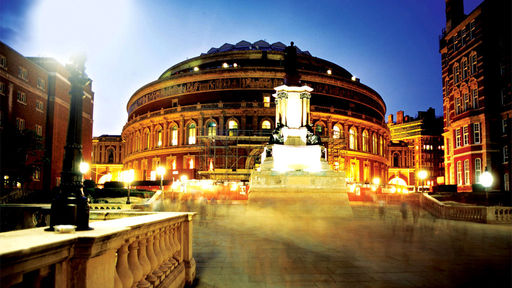
The Prom concert on August 24, by the London Symphony Orchestra and Chorus, conducted by Valery Gergiev, opened with Nagasaki by Alfred Schnittke, his graduation piece from the Moscow Conservatory. In this piece for chorus, solo mezzo-soprano, and large orchestra (including a theremin), Schnittke set texts reflecting on the devastation of the Japanese city by the atomic bomb at the end of the Second World War by Anatoly Sofronov, described in Calum MacDonald’s program notes as “the official Soviet propaganda poet”, along with poems by two Japanese poets, Eisaku Yoneda and Shimazaki Tōson.
Although the piece was accepted by the Moscow Conservatory, its finale was considered by the Soviet Composers Union as not optimistic enough (probably only a Soviet bureaucrat could demand from a piece about the aftermath of a nuclear attack); Schnittke was accused of having succumbed to”Expressionism” and “forgetting the principles of Realism in music.” Schnittke rewrote the finale, using additional text by his friend Gerogy Fere, and it was approved for performance, which is received in 1959. It was not performed again in Schnittke’s lifetime.
Since it is basically a student piece and from the 50’s, it is probably not surprising that Nagasaki has none of the extreme modernist and post-modernist“funny business” which one thinks about as being characteristic of Schnittke’s music. It’s a rather straight-forward, very strong, very accomplished, very effective piece, showing the influence of Shostakovich. The first movement, which seems a little as though it might be the beginning of the St. Matthew Passion as arranged by Shostakovich, lingers strongly in this listener’s memory.
The second half of the concert was the Eighth Symphony of Dimitri Shostakovich. It is so easy to think about Shostakovich only in terms of his being some kind of political football, that it is often a surprise to come in contact with a piece that, due to an absence of a sexy back story and simply by its sheer quality, makes you realize just what a good composer he was–especially what a brilliant orchestrator. It’s full of striking material and endlessly inventive orchestration, but also very sure in its construction, with a very tight dramatic trajectory. The quieter philosophical last movement and particularly the long gentle coda, with its very light texture featuring a series of instrumental solos accompanied with strikingly unexpected combinations of instruments, is especially memorable. Its hard to imagine either of these pieces receiving better performances than Gergiev and the LSO gave them. (more…)
 Tonight’s performance by Charlemagne Palestine was, in short, one of the most extraordinary musical experiences of my life. Palestine has developed a technique for playing the organ which involves the use of wooden shims to hold down keys so he can build up drones with many notes and still have his hands free to improvise melodies over top of it. He starts with an open fifth and builds over the course of a couple hours to a dense roar that uses most of the available power of the instrument. It was mesmerizing. In truth, I wasn’t expecting to like it much — I expected it to be long and loud and somewhat interesting but ultimately boring. I couldn’t have been more wrong, and I urge you that if you ever have an opportunity to hear Palestine play you not miss it for anything.
Tonight’s performance by Charlemagne Palestine was, in short, one of the most extraordinary musical experiences of my life. Palestine has developed a technique for playing the organ which involves the use of wooden shims to hold down keys so he can build up drones with many notes and still have his hands free to improvise melodies over top of it. He starts with an open fifth and builds over the course of a couple hours to a dense roar that uses most of the available power of the instrument. It was mesmerizing. In truth, I wasn’t expecting to like it much — I expected it to be long and loud and somewhat interesting but ultimately boring. I couldn’t have been more wrong, and I urge you that if you ever have an opportunity to hear Palestine play you not miss it for anything. A day that starts at 9AM and ends after 11 at night, in which 15 different people give presentations, and which culminates in a two hour concert, is not a day that is easy to distill down to a single theme (except perhaps happy exhaustion). We began with no fewer than six papers on Steve Reich, some of which were thematically linked but none of which was redundant. Perhaps my favorite moment of those morning sessions was when Sumanth Gopinath compared a feature of Different Trains to the music from a classic 1980s IBM commercial. In the afternoon we had papers on Part, Eastman, Glass, and Young. Kyle Gann described his painstaking reconstruction of Dennis Johnson‘s pivotal-yet-nearly-lost November, which Kyle and Sarah Cahill will be performing in all its 5-hour glory on Sunday. And at the end of the day the great Tom Johnson, who was the Downtown critic for the Village Voice from 1971 to 1982 and who now lives in Paris, gave an hour-long presentation on European minimalist music that we in the United States aren’t familiar with, and on some of his own music. Johnson’s book The Voice of New Music is essential reading for anybody who wants to understand minimalism, and it was a real thrill to hear his current thoughts on the European scene.
A day that starts at 9AM and ends after 11 at night, in which 15 different people give presentations, and which culminates in a two hour concert, is not a day that is easy to distill down to a single theme (except perhaps happy exhaustion). We began with no fewer than six papers on Steve Reich, some of which were thematically linked but none of which was redundant. Perhaps my favorite moment of those morning sessions was when Sumanth Gopinath compared a feature of Different Trains to the music from a classic 1980s IBM commercial. In the afternoon we had papers on Part, Eastman, Glass, and Young. Kyle Gann described his painstaking reconstruction of Dennis Johnson‘s pivotal-yet-nearly-lost November, which Kyle and Sarah Cahill will be performing in all its 5-hour glory on Sunday. And at the end of the day the great Tom Johnson, who was the Downtown critic for the Village Voice from 1971 to 1982 and who now lives in Paris, gave an hour-long presentation on European minimalist music that we in the United States aren’t familiar with, and on some of his own music. Johnson’s book The Voice of New Music is essential reading for anybody who wants to understand minimalism, and it was a real thrill to hear his current thoughts on the European scene.
 Up and running for a few weeks now,
Up and running for a few weeks now, 


 Our pal
Our pal